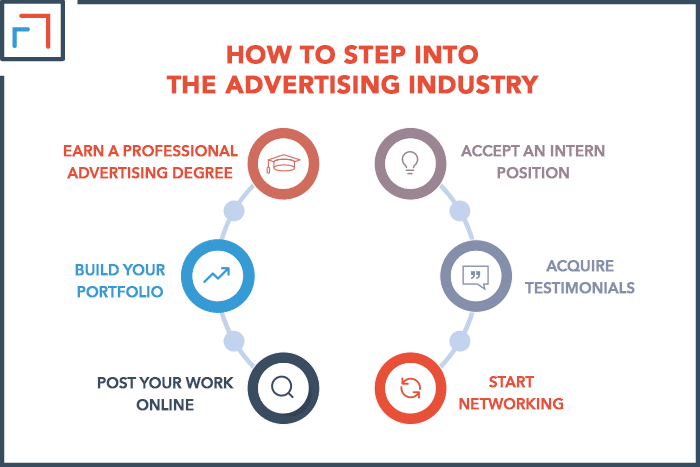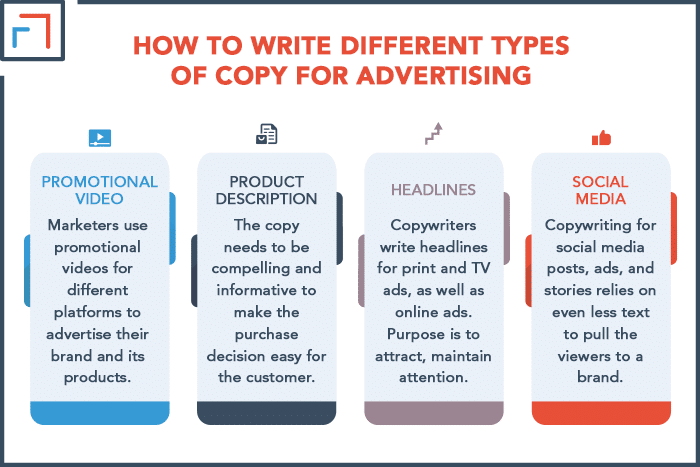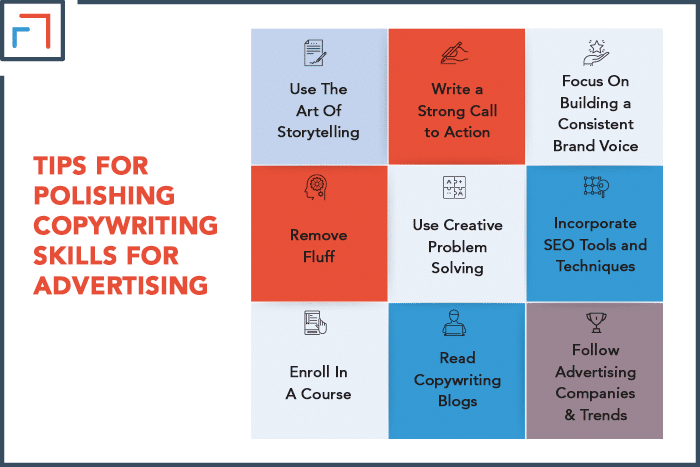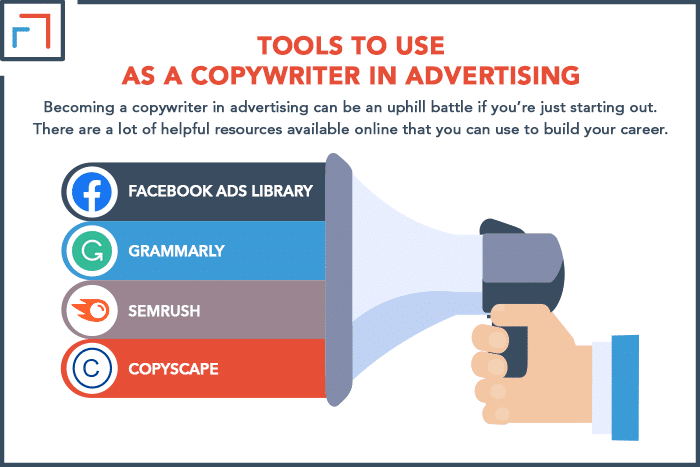If you’ve been impressed by a witty, inspirational, or creative advertisement, you might want to explore the possibility of becoming a copywriter. If you’re already a writer, you’ve already taken your first step in the process.
You can begin your copywriting journey in advertising by earning a professional advertising degree and taking a few reputable copywriting courses. Next, build your portfolio by either interning in an office or freelancing. The objective is to acquire lots of testimonials and on-the-job experience.
You need to be strategic if you want to become a copywriter for advertising. This is because there is a lot of competition and there are high expectations in this field. Hence, it’s important to know some strategies that will help you build a career in this industry.
How To Step Into the Advertising Industry?
1. Earn a Professional Advertising Degree
Getting a good education and a degree is a great place to start.
An educational background in copywriting, marketing, or advertising is a preference for recruiters and hiring managers in this industry.
If you are ambitious about copywriting in advertising, you should explore college degrees within your budget.
Online certifications can go a long way as well. The degree would also help you gain more copywriting-related skills and a better understanding of the industry.
2. Build Your Portfolio
Over time, you can create a niche for your copywriting work to demonstrate your knowledge and experience.
For example, you might write copy for online ads, including metadata and title tags.
But if you don’t have enough experience to develop a niche, you can simply choose your best samples and show a wide diversity of work.
You can also use your writing skills and online research to start a blog about copywriting techniques.
This will become part of your portfolio and will also help you attract clients who might need freelance copywriters for their projects.
3. Post Your Work Online
If you have a piece of writing that you’re particularly proud of, try to get it published on a well-respected website.
You can reach out to brands that interest you or submit your work to magazines.
If your work grabs a lot of attention, you have made your first foothold in the world of professional copywriting.
4. Accept an Intern Position
Since the advertising industry is fast-paced, many agencies look for ambitious and hardworking interns who can take care of the basic parts of their work.
As an intern, you may need to create storyboards, proofread text, deliver ideas and outlines for ads, etc.
As an intern, you’ll have the chance to make a good impression and get on good terms with advertising professionals.
5. Acquire Testimonials
If you have worked with a few clients as a copywriter, ask them for reviews and testimonials.
This will add substance to your resume and portfolio, making it easier for future employers to hire you.
Gather good industry contacts, so your future employers have references to reach out to.
6. Start Networking
Even if you don’t have a professional degree or a lot of experience, strong networking skills can fill that void.
Use social events as an opportunity to expand your network and build new professional relationships.
Don’t be afraid to seek out brands that you’re interested in and see if they’re hiring. You can build working relationships with clients and their contacts.

How To Write Different Types Of Copy for Advertising?
Advertising copywriters write content that helps a business sell its product or service. Crafting a good call to action is essential.To improve as a copywriter in advertising, use storytelling, do your research, study market trends and develop a tone that connects with your brand audience.
1. Promotional Video
Marketers use promotional videos for different platforms to advertise their brand and its products.
As a copywriter, you must write copy that aligns with the visuals, all while maintaining a consistent brand voice.
You have to ensure that your copy intensifies the viewers’ emotions.
Therefore, you wouldn’t merely support the video with your copy but enhance its effect on the viewers.
For example, you might introduce the audience to a common problem at the beginning of the video. You then add emotion to the problem through your copy.
This will make your copy relatable to the audience, which prepares them to accept the solution that you present.
Your copy replaces the previous emotions around the audience’s problem with the hope and relief for a solution.
This is the point where you make good use of the emotional buildup from the video and push the viewers to engage with your brand.
Your entire copy should lead up to a solid call to action at the end.
2. Product Description
While writing the product description, copywriters must remember that whoever reads this description is interested in the product to some extent.
Therefore, your copy needs to be compelling and informative to make the purchase decision easy for the customer.
An effective product description answers the following questions.
- What is it?
- What does it do?
- How does it help the user?
- Does it have other valuable benefits?
Moreover, if the product is ethically produced and environmentally sustainable, then these are persuasive features to add to the product description.
You should emphasize anything that makes customers feel better about buying from you.
The title for the product should be attention-grabbing and include targeted keywords that improve the webpage’s SEO ranking.
3. Headlines
Copywriters write headlines for print and TV ads, as well as online ads.
While the copy should be tweaked according to each platform’s audience and content regulations, the general purpose is to attract and maintain attention.
Sometimes, copywriters overlook the importance of maintaining the audience’s attention by failing to focus on the text after the headline.
Therefore, make sure that the suspense you’re creating with your headline is followed by relevant and impactful copy.
You could adopt different types of copywriting styles for headlines. There are some good practices to follow when it comes to crafting headlines. These include:
- Simple and direct copy which is easy to understand
- Using relevant and research-backed facts to convince the audience
- Using storytelling to deliver an impression of the brand experience
- Listing key features to educate and grab attention
- Personalizing your headlines to create a direct connection with the audience
4. Social Media
A lot of content creation takes place on social media, so it has become a powerful platform for advertisers.
Copywriting for social media posts, ads, and stories relies on even less text to pull the viewers to a brand.
Because of the limited amount of text you have to work with, you must work hard to deliver your message in a clear and compelling way.
Advertising on social media is also challenging because of the endless content and competition that is out there.
Your social media copywriting must cater to the valuable yet short attention span of the user.
This type of copy needs to compel the viewer to stay on the brand’s account or post for a longer period of time.
The copy should also be distinct and memorable so that the audience doesn’t forget about the brand in a few hours.
This is why using a defined and consistent brand voice is important.

10 Tips For Polishing Copywriting Skills For Advertising
To improve as a copywriter in advertising, use storytelling, do your research, study market trends and develop a tone that connects with your brand audience.
1. Use The Art Of Storytelling
Build an emotionally-charged narrative around your brand through relatable storytelling.
The picture that you’re painting should be the one that your audience is pleased with and interested to see.
By carefully studying your brand’s target audience, develop copy that makes it easy for consumers to visualize the promised brand experience.
Make sure that you are following a strategic plan for your storytelling so that you achieve results that meet your goals.
Once you have a plan, you can get creative with your story so that it sticks with the audience even after they have moved on to something else.
A good story is more memorable than any product.
2. Write a Strong Call to Action
As a copywriter in advertising, you will be writing a lot of calls to action for different types of copies and platforms.
Therefore, you need to align your call to action with the goals for that specific copy.
Using clear imperatives for your CTA makes it easier for the audience to act and engage with your brand in the preferred way.
Your CTA might push them to learn more, shop, buy, subscribe, or join.
Make sure you’re pushing the consumer to make a decision that offers them significant value at a low cost.
To encourage a prompt consumer decision, add deadlines for the offer, such as limited slots/stock or a one-week discount.
Your CTA should also be clearly visible and distinguishable from the rest of the copy. Be sure to add some space around it, so it stands out.
3. Focus On Building a Consistent Brand Voice
Create a board with visuals and text templates that match the brand’s tone and voice.
Use this board as a guide to create content that is consistent with your client’s brand identity.
Keep referring to published copies for the brand to make sure that your copy has the same appearance and tone of voice.
Even if you don’t have clients yet, you could take a company’s existing campaign and show how you would improve the copy by making tweaks or complete rewrites.
Study their tone to show how you can match the brand’s writing style. You can add these samples to your portfolio as well.
4. Remove Fluff
As a copywriter, you have a limited word count to grab the reader’s attention, give them an experience and persuade them to act.
This leaves no room for fluffy content. Copywriters have to get to the point quickly.
Reread your copy and remove filler words. Assess how you can make your sentences simpler and more impactful.
Avoid using too many big words in your copy since that risks alienating the audience.
Understand your audience and pick your vocabulary accordingly. You might need to use technical language to establish credibility for an advanced audience.
In addition, use storytelling to elicit emotions in your readers rather than relying on a ton of adjectives.
5. Use Creative Problem Solving
With lateral thinking, copywriters can develop innovative copy ideas.
This also extends to incorporating design elements and technology in copywriting to deliver a creative advertising solution.
This process helps writers brainstorm freely and move past potential writing blocks.
Keep the customer’s needs in mind by mapping out the audience’s problems and the different ways that your client can solve these issues.
Then use your understanding of the market and competition to amplify the value that your client can provide.
In short, stop thinking that you’re writing to sell (even if that is the intent). Instead, think of your writing as a way to solve a problem.
This will create a more genuine voice and help you bring creative ideas to the table.
6. Incorporate SEO Tools and Techniques
Use research to find out the various SEO tools and techniques that are being used for copywriting.
This is important because copywriting is specifically designed to reel in the audience.
SEO practices help copywriters understand how to develop copy with high readability levels, which attracts greater audience interest.
7. Enroll In A Course
Many accessible and affordable online courses will help you develop copywriting skills.
You could also explore advertising or storytelling courses that teach students about new strategies and trends in consumer behavior.
8. Read Copywriting Blogs
Read blogs of professionals in advertising and copywriting.
Learning from successful advertisers will help you gain expert insight on how to improve as a copywriter, what to focus on, and how to build your career in the industry.
You can also ask them to critique your copywriting samples and request specific tips.
They may not always be available for this kind of one-on-one work, but it doesn’t hurt to ask!
9. Follow Advertising Companies & Trends
Find inspiration by looking at advertising trends and campaigns of brands from all around the world.
This will not only help you be more creative with your copywriting, but you’ll also stay informed about the latest successful advertising strategies.
If you have an interview for a copywriting role, try mentioning campaigns that have inspired you.
This is an effective way to showcase your interest and dedication to the craft.

Tools To Use As A Copywriter In Advertising
1. Facebook Ads Library
This is a great place to find inspiration and stay informed about different types of Facebook ads that are created.
In addition, this library shows all the advertisements that have run on Facebook.
2. Grammarly
You can tweak your copy quickly using Grammarly’s recommendations.
In addition, you can use its proofreading features to spot your grammar and spelling errors.
If you’re compiling your samples to add to your portfolio, consider reviewing them through Grammarly first.
Though minor errors in spelling and grammar may not seem like a big deal, they can impact your professional credibility.
3. SEMrush
Writers can adjust their copy according to the statistics and results that this tool provides.
You can also find out consumer intent through their searches and develop copy accordingly.
SEMrush helps copywriters use data-driven research to create their strategies.
4. Copyscape
Since you will be exposed to a lot of advertising campaigns, you need to make sure that you don’t end up accidentally plagiarizing content.
You can use tools like Copyscape to check your copy. It’s essential to maintain your professional credibility and avoid losing clients.

In Summary…
Becoming a copywriter in advertising can be an uphill battle if you’re just starting out.
But there are a lot of helpful resources available online that you can use to build your career.
The most crucial step is to keep writing, develop a portfolio and identify your weaknesses so you can work on them.
